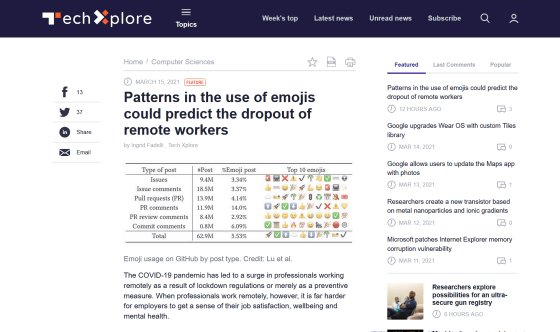By observing the usage patterns of pictograms, it may be possible to predict the 'risk of remote workers resigning'.

With the pandemic of the new coronavirus, more and more companies are introducing remote work, but one of the challenges is for employers to know the well-being, job satisfaction, and mental health of employees working remotely. .. A new international research team from the University of Michigan, the University of Maryland, and Peking University said, 'Observing pictogram usage patterns may predict the risk of remote employees leaving.' I reported.
[2102.05737] Emojis Predict Dropouts of Remote Workers: An Empirical Study of Emoji Usage on GitHub
Patterns in the use of emojis could predict the dropout of remote workers
https://techxplore.com/news/2021-03-patterns-emojis-dropout-remote-workers.html

'Working remotely makes it difficult to track a colleague's emotional and mental health status, which is a major challenge during pandemics and future work,' said Xuan Lu , the lead author of the treatise at the University of Michigan. Tells TechXplore, a tech media.
Text messages are the primary means of communication during remote work, and more and more companies are adopting chat tools such as Slack. 'Despite the reduced face-to-face conversations, we've found that remote workers frequently use emoji in their work-related online communications and can be used as an effective sensor to show emotions at work,' Lu said. Mr. comment.
So Lu's research team analyzed the texts of about 10 million software developers using the software management platform GitHub. We investigated the relationship between the frequency of emoji usage and the work status of posters in 63 million texts posted in 2018.

As a result of the analysis, it was found that 5.53% of the posts contained some kind of emoji, and that there was a difference in the frequency of using emoji depending on the programming language and the type of post. There were 264,808 developers using emoji, and it was also found that these users posted 52.78% of all posts on GitHub in 2018. This indicates that the use of emoji may be related to the liveliness of communication on the platform.
In addition, when the research team investigated the correlation between the frequency of emoji usage in posts in 2018 and the rate of withdrawal from using GitHub in 2019, the percentage of users who use less emoji quit GitHub It became clear that the rate of quitting GitHub tends to be low as the use of emoji increases.
'Our findings suggest that emoji usage is associated with the risk of dropping out of the online work platform,' Lu said. 'Developers who use emoji in their posts drop out of GitHub. It turns out that it's much less likely, 'he said. By analyzing the frequency of emoji usage in developer posts with a machine learning model, it is possible to predict future dropouts from the platform with sufficient accuracy.
The findings relate to posts on GitHub and dropouts from the platform, but in the future they will measure remote worker job satisfaction based on the use of emoji, and show signs of mental health deterioration and depression. It may be detected and lead to the development of a system that supports employees.

Related Posts:
in Web Service, Science, Posted by log1h_ik







